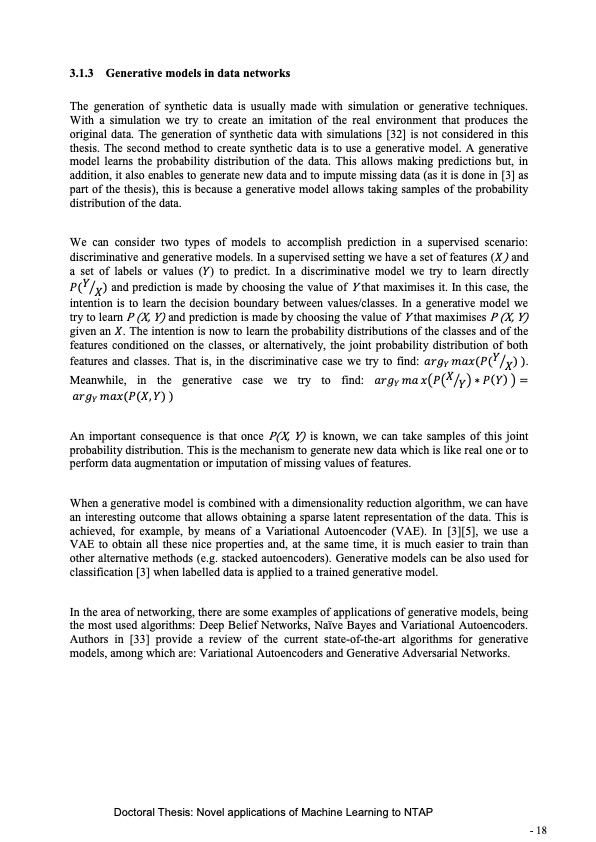
PDF Publication Title:
Text from PDF Page: 020
3.1.3 Generative models in data networks The generation of synthetic data is usually made with simulation or generative techniques. With a simulation we try to create an imitation of the real environment that produces the original data. The generation of synthetic data with simulations [32] is not considered in this thesis. The second method to create synthetic data is to use a generative model. A generative model learns the probability distribution of the data. This allows making predictions but, in addition, it also enables to generate new data and to impute missing data (as it is done in [3] as part of the thesis), this is because a generative model allows taking samples of the probability distribution of the data. We can consider two types of models to accomplish prediction in a supervised scenario: discriminative and generative models. In a supervised setting we have a set of features (𝑋) and a set of labels or values (𝑌) to predict. In a discriminative model we try to learn directly 𝑃(𝑌⁄𝑋) and prediction is made by choosing the value of Y that maximises it. In this case, the intention is to learn the decision boundary between values/classes. In a generative model we try to learn P (X, Y) and prediction is made by choosing the value of Y that maximises P (X, Y) given an 𝑋. The intention is now to learn the probability distributions of the classes and of the features conditioned on the classes, or alternatively, the joint probability distribution of both features and classes. That is, in the discriminative case we try to find: 𝑎𝑟𝑔𝑌 𝑚𝑎𝑥(𝑃(𝑌⁄𝑋) ). Meanwhile, in the generative case we try to find: 𝑎𝑟𝑔𝑌 𝑚𝑎 𝑥(𝑃(𝑋⁄𝑌) ∗ 𝑃(𝑌) ) = 𝑎𝑟𝑔𝑌 𝑚𝑎𝑥(𝑃(𝑋, 𝑌) ) An important consequence is that once P(X, Y) is known, we can take samples of this joint probability distribution. This is the mechanism to generate new data which is like real one or to perform data augmentation or imputation of missing values of features. When a generative model is combined with a dimensionality reduction algorithm, we can have an interesting outcome that allows obtaining a sparse latent representation of the data. This is achieved, for example, by means of a Variational Autoencoder (VAE). In [3][5], we use a VAE to obtain all these nice properties and, at the same time, it is much easier to train than other alternative methods (e.g. stacked autoencoders). Generative models can be also used for classification [3] when labelled data is applied to a trained generative model. In the area of networking, there are some examples of applications of generative models, being the most used algorithms: Deep Belief Networks, Naïve Bayes and Variational Autoencoders. Authors in [33] provide a review of the current state-of-the-art algorithms for generative models, among which are: Variational Autoencoders and Generative Adversarial Networks. Doctoral Thesis: Novel applications of Machine Learning to NTAP - 18PDF Image | Novel applications of Machine Learning to Network Traffic Analysis

PDF Search Title:
Novel applications of Machine Learning to Network Traffic AnalysisOriginal File Name Searched:
456453_1175348.pdfDIY PDF Search: Google It | Yahoo | Bing
Cruise Ship Reviews | Luxury Resort | Jet | Yacht | and Travel Tech More Info
Cruising Review Topics and Articles More Info
Software based on Filemaker for the travel industry More Info
The Burgenstock Resort: Reviews on CruisingReview website... More Info
Resort Reviews: World Class resorts... More Info
The Riffelalp Resort: Reviews on CruisingReview website... More Info
| CONTACT TEL: 608-238-6001 Email: greg@cruisingreview.com | RSS | AMP |